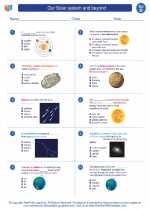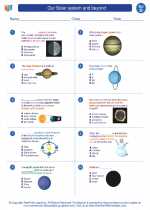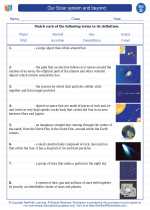Our Solar system and beyond -> eris
Eris
Eris is a dwarf planet in our solar system, located in the Kuiper Belt. It was discovered in 2005 and is one of the largest known dwarf planets. Here's a study guide to learn more about Eris:
1. Discovery
Eris was first observed in January 2005 by a team of astronomers led by Mike Brown at the Palomar Observatory in California. Its discovery led to a reclassification of what constitutes a planet, ultimately leading to the creation of the "dwarf planet" classification.
2. Physical Characteristics
Eris has a diameter of about 1,445 miles (2,326 kilometers), making it slightly smaller than Pluto. It is primarily composed of rock and ice, similar to other objects in the Kuiper Belt. Eris has one known moon, named Dysnomia, which is thought to be about 150 miles (240 kilometers) in diameter.
3. Orbit and Location
Eris has a very elliptical orbit and takes about 557 Earth years to complete one orbit around the Sun. Its distance from the Sun varies from about 38 to 98 astronomical units (AU), with 1 AU being the average distance between the Earth and the Sun. This means that Eris is located much further from the Sun compared to the eight classical planets.
4. Comparison to Pluto
Initially, Eris was thought to be larger than Pluto, sparking a debate about whether it should be considered the tenth planet in our solar system. This debate ultimately led to the reclassification of Pluto as a dwarf planet, along with Eris and other similar objects in the Kuiper Belt.
5. Importance to Science
Studying Eris and other objects in the Kuiper Belt provides valuable insights into the early solar system and the formation of planets. Eris and its moon Dysnomia also offer opportunities to learn more about the dynamics and characteristics of distant, icy bodies in our solar system.
By understanding Eris and its place in the solar system, scientists can continue to unravel the mysteries of our cosmic neighborhood and gain a deeper understanding of planetary formation and evolution.
[Eris] Related Worksheets and Study Guides:
.◂Science Worksheets and Study Guides Fourth Grade. Our Solar system and beyond

 Worksheet/Answer key
Worksheet/Answer key
 Worksheet/Answer key
Worksheet/Answer key
 Worksheet/Answer key
Worksheet/Answer key
 Vocabulary/Answer key
Vocabulary/Answer key
 Vocabulary/Answer key
Vocabulary/Answer key
 Vocabulary/Answer key
Vocabulary/Answer key
